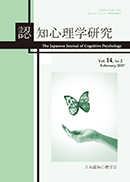Volume 14, Issue 2
Displaying 1-4 of 4 articles from this issue
- |<
- <
- 1
- >
- >|
Original Articles
-
2017 Volume 14 Issue 2 Pages 57-67
Published: February 28, 2017
Released on J-STAGE: April 06, 2017
Download PDF (424K) -
2017 Volume 14 Issue 2 Pages 69-82
Published: February 28, 2017
Released on J-STAGE: April 06, 2017
Download PDF (356K)
Research Report
-
2017 Volume 14 Issue 2 Pages 83-90
Published: February 28, 2017
Released on J-STAGE: April 06, 2017
Download PDF (284K)
-
2017 Volume 14 Issue 2 Pages 91-92
Published: February 28, 2017
Released on J-STAGE: April 06, 2017
Download PDF (162K)
- |<
- <
- 1
- >
- >|
